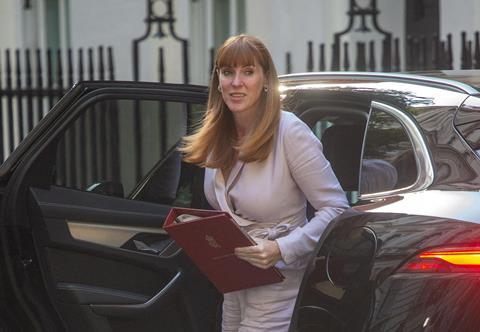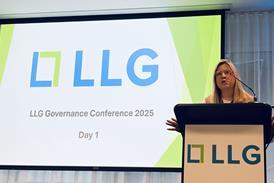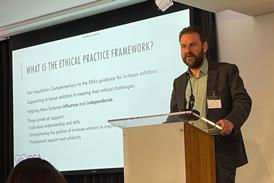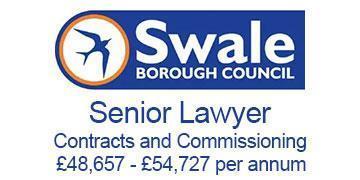The low down
Conveyancing departments struggle to attract junior recruits, while the pressures of the job – combined with high risks and low margins – mean many practitioners plan to leave the sector. This is bad news for the government, as solicitors are needed to help get first-time buyers on the property ladder and keep prices buoyant. What would induce residential property solicitors to stay? Perhaps reform could lower both the risks and complexity of conveyancing, in the process reducing the incidence of failed transactions. Eye-catching proposals include ‘property log books’ and an increase in the accessibility of data – the latter entailing an end to the sector’s ubiquitous use of PDFs. But don’t mortgage lenders need to change too?
It is often observed that the conveyancing process may be the only time many people come into contact with the legal profession – and it is under growing critical scrutiny. Research published by Santander last month revealed the extent to which ‘a flawed housing system’ is affecting UK consumers and called for ‘significant reform’ of the homebuying process.
Santander’s report had its critics among Gazette readers, some of whom noted that recommendations for reform were short on suggestions that would entail a change in the way lenders operate.
The report did, however, make an uncontested point: the cost to consumers of failed transactions is high – £560m annually, according to Santander’s research. In addition, 23% of consumers have experienced a property chain failing.

Stamp duty policy must be ‘front and centre’
Miscalculation of stamp duty land tax (SDLT) is one area identified in analysis by broker Howdens as a top-five risk for conveyancers. Common causes of claims include conveyancers failing to apply for multiple dwelling relief, failure to advise on additional stamp duty on second homes and failure to advise on certain reliefs or surcharges.
The recent resignation of deputy prime minister Angela Rayner is a reminder of the complexities of the SDLT rules, and in particular those relating to owning a second home. Rayner’s case was particularly complex, involving a trust with her son as beneficiary. Even though she had sold her share in the trust, she was deemed to still hold an interest in it, and so should have paid the stamp duty that attaches to purchasing a second home.
Her solicitors on the flat purchase, Verrico & Associates, denied giving her tax advice. The firm said it relied on figures and information provided by Rayner, which led to her initial underpayment of SDLT.
It can be difficult for conveyancers to know when to refer a matter to a tax specialist, says Amanda Perrotton, a partner at central London firm Bell Howley Perrotton who provides SDLT training to other solicitors. ‘My advice is that if you can plug the calculations into the government calculator and work out what the SDLT is, if you know just by the nature of transaction that no surcharges or reliefs will apply, you are covered by your PII to give that advice effectively,’ she says. ‘When it comes to reliefs and surcharges, there is no guidance. If you look at the [Law Society] Conveyancing Quality Scheme it states that in order to be authorised to use the CQS badge you need to have an SDLT policy in place.
‘Some firms have interpreted that as meaning that if a surcharge or a relief applies, the transaction becomes complex, and they automatically generate a letter out to their client saying that “we have calculated the SDLT, but based on the answers you’ve given us to our standard SDLT questionnaire, we believe the matter to be complex and therefore you need to take independent tax advice”.’
Client education on the conveyancing process is important, adds Perrotton. ‘We have failed to educate the client that this is not straightforward, by saying: “I am not a surveyor, I am not an environmental specialist, and I am certainly not a tax adviser”,’ she says. ‘There needs to be a two-stranded approach. The first is to protect the firm. Solicitors complete forms and send them to their clients; it’s up to the clients to confirm that the information they are providing is accurate. My advice to firms is to check if they are regulated or insured to give the relevant advice. So, it’s not about “can you calculate the SDLT?”, but “should you calculate it?”. The second thing is to ensure that your SDLT policy, your letter of engagement, your terms of business and your SDLT questionnaire reflect that. It needs to be front and centre, so it’s clear to the client exactly what their scope of work is.’
Government steps in
Earlier this year, the Ministry of Housing, Communities and Local Government announced that it would streamline the conveyancing process to make it fit for the 21st century. It identified the lack of digitisation as a key reason for delays.
The reforms are intrinsic to the government’s ‘Plan for Change’ to deliver 1.5 million homes in this parliament, helping ‘working people who want to get on the property ladder’, and sit alongside its promise to reform leasehold.
A report by the Digital Property Market Steering Group (DPMSG), formed in 2023 by HM Land Registry and comprising key industry partners including the Law Society, followed in August. It identified digitisation as a prerequisite for improvement. To achieve that, greater confidence in robust processes for identity and professional verifications needs to be built, it noted.
Key to this will be the use of upfront information before a property is listed, the introduction of a digital property logbook, which would hold all data relating to a property, and the use of GOV.UK’s One Login for identity verification at various stages of the process, including exchange of contracts and mortgage applications.
While the report acknowledges the pressures on solicitors, with the ‘fear of being sued’ ever prevalent, there has been a mixed reaction from residential property lawyers to these latest proposals. Conveyancing remains the practice area attracting the most negligence claims. While some firms have embraced digitisation, others say the proposals fail to recognise the challenges they face daily and are calling for greater involvement.
Stephen Larcombe of South West Legal Locum Services believes that the DPMSG report fails to understand the real issues facing property lawyers: ‘This report reminds me a bit of a consultant surgeon being told by a photocopy salesman, “we are now going to transform the way you operate on patients. Would you mind getting out of the way while we tell you how it’s going to happen”,’ he says. ‘If they really want to accelerate the home-buying process, they should be consulting with experienced solicitors. If they did, my first comment would be: stop imposing 1,500 pages of anti-money laundering guidance and stop coming out with bad legislation.’
Law Society vice-president Mark Evans acknowledges that ‘conveyancers face a lot of pressure, but it is often one of the most important parts of the legal profession for the public’.
He adds: ‘Technology has an important role to play in improving the process, but it is just one part of the conveyancing puzzle. Improving technology without addressing other factors will not deliver real gains for clients or conveyancers.’
Liability lottery
A lack of consumer education, increasingly complex legislation and lack of communication between parties are just some of the challenges conveyancers face, notes the DPMSG report. Conveyancers remain troubled by the lack of clarity about where liability sits when things go wrong.
Zahrah Aullybocus, a consultant at Nexa Law, London, has concerns about the full digitisation and standardisation of data-sharing mechanisms, including the proposed property log book: ‘Who’s running it in the background? Who is interpreting the results and who is going to be liable if it’s wrong? If that responsibility lands on the lawyers involved, their professional indemnity insurance is going to go through the roof.’
Volume conveyancers, often instructed on transactions as a fee arrangement via estate agents, are a source of frustration for residential property lawyers, who complain that such firms are often staffed by inexperienced case-handlers, with minimal supervision. ‘A lot of them wouldn’t spot a complex legal structure if it hit them in the face,’ says Aullybocus.
Yanthé Richardson, partner at Foot Anstey, Taunton, sits on the Land Registry Advisory Committee and the DPMSG. She believes that in the longer term, the introduction of property logbooks should make it easier to provide information up front: ‘My real concern is more on the way that the consumer receives it, so it needs to be presented in the right way. Terminology, such as “restrictive covenant” could put a buyer off instead of encouraging them. So, it’s about education and making sure that we are providing information to a potential buyer who has not yet consulted a lawyer.’
Obstacles to digitisation
The DPMSG report notes that several barriers exist to secure data sharing, notably PDFs remaining in common use, hindering easy access and integrations, historical records still being in paper form, and a general reluctance in the industry to share valuable data. It recommends the adoption of GOV.UK’s One Login for buyers and sellers.
The report notes that obstacles to digitisation include a lack of industry training and a skills gap in the profession. The prevalence of PDFs and scanned documents in the sector ‘hinders the ability to effectively utilise digital data’.
Larcombe disagrees: ‘Lawyers are keen to do the best they can for their clients and they will embrace new technology. But because of our legal training, and because of our desire to act professionally and with integrity, we won’t accept technology blindly.’
Electronic signatures will not be suitable for every situation, says Aullybocus: ‘I do everything electronically, but I have clients who struggle with it, and we have to cater to everyone’s needs. We also still have mortgage lenders that don’t accept digital signatures. In theory, anyone could sign a document if it’s just a typed signature. If, for example, you are in a coercive relationship, how is that going to prevent that type of abuse?’
Foot Anstey’s Richardson believes that electronic signatures that are backed by biometric ID allay any such worries. ‘I understand the concern around coercion, but I don’t think that’s new, and biometric ID is quite hard to fake,’ she says. ‘Those are really outlying cases. The real win is the speed, efficiency and convenience, which clients expect now because it’s what they are getting in every other aspect of their lives.’
Yorkshire firm Ison Harrison adopted digital ways of working as the firm came out of Covid lockdowns, explains Daniel Kenworthy, assistant head of residential conveyancing: ‘When we engage with most clients, we will do so on an electronic basis. The client can access our quote through a portal, and release their engagement forms instantly, so the onboarding is a lot quicker.’
Electronic ID checks and biometric verification can be carried out by clients at home, ‘rather than coming to us’, Kenworthy explains. ‘Gathering a buyer’s source of funds is a painful part of the process. It takes a lot of time and clients can feel that certain information is intrusive. We are now giving clients open banking tools, which makes gathering information easier and provides better data. It’s also a bit more discreet and definitely safer than sharing bank statements over open emails.’
He acknowledges that not all clients will feel comfortable working in this way and, while 70% are happy to be ‘onboarded’ electronically, the remainder still prefer not to be.
Richardson says the real challenge with digitisation is in its adoption by legal practices. ‘Government and the Land Registry cannot kitemark or endorse particular providers. What they’ll do is provide guidance. If you’re at a practice like ours, we have transformation people and data specialists. But if you are a sole practitioner, the burden is on you to find a provider that meets the requirements of my PII insurers, my regulator, the lender and the clients I am acting for,’ she says. ‘That, I believe, could be a real barrier to adoption.’
Succession and attrition
Attrition rates remain high among conveyancers. An analysis of Land Registry data by Search Acumen in the summer showed a 4% drop in the number of property law firms active in 2024/25. Meanwhile, the number of conveyancers fell by 15% from 2021 to 2025, according to Law Society data published in IRN Legal Reports’ latest market report.
A report by TM Group in 2023 revealed that one in three conveyancers was planning to quit in the next five years. One such solicitor is Pardeep Kandola, who announced on LinkedIn last month that he was quitting frontline conveyancing, describing it as a ‘thankless task’ with very little respect shown to the profession.
Attracting junior lawyers is also challenging. ‘Succession is a real issue in residential conveyancing,’ says Richardson. ‘It’s not a very popular specialism for law students. We should utilise technology to demonstrate to the next generation of lawyers that this is an area of the law which is actually interesting and complex. At the moment, we spend so much of our time on the administrative stuff. This could be made much simpler through the use of technology and allow us to focus on the actual legal advisory piece.’
The DPMSG report covers more than just the legal profession. It also incorporates proposals relating to estate agents, surveyors and lenders.
Richardson acknowledges that trying to get all those involved in the conveyancing process to work together to foster improvements is difficult. ‘It’s not an easy task without mandation. That’s the key. Unless it’s mandated, we have to get everybody to voluntarily do these things,’ she says. ‘Change is going to come and we need to work together to find ways in which we can improve this process for our clients, because ultimately they are the most important people in all of this.’
Maria Shahid is a freelance journalist
































No comments yet